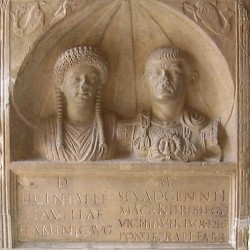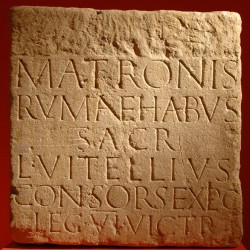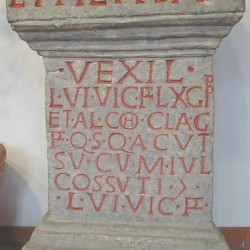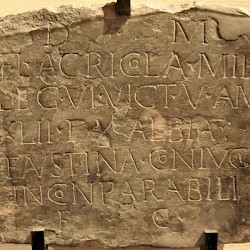Legio VI Victrix
Legio VI Victrix: one of the Roman legions. Its name means "the victorious legion".

The sixth legion was founded by Octavian (the future emperor Augustus) in 41 BCE, as a copy of the Caesarian sixth legion, which was in the army of his rival Mark Antony. Perhaps veterans who had fought under Caesar joined Octavian's unit. Although there was no formal continuity, some of the soldiers maintained the traditions of the Caesarian legion. The new (or renewed) legion saw its first action during the siege of Perugia in the same year. Sling stones with the number VI attest to its presence.
It later served against Sextus Pompeius, who had occupied Sicily and threatened to cut off the grain supply of Rome. In 31, the Sixth was present during the battle of Actium against Mark Antony. (The real fighting, however, was done by Octavian's navy.) After 30, it was stationed in Hispania Tarraconensis, where it took part in Augustus' campaigns against the Cantabrians, which lasted from 25-13 BCE. This was a very large war: among the other troops involved were I Germanica, II Augusta, IIII Macedonica, V Alaudae, VIIII Hispana, X Gemina (which seems to have shared its base, perhaps near Braga, with our unit), XX Valeria Victrix, and another legion, perhaps VIII Augusta.
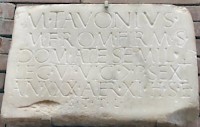
VI Victrix was to stay in Hispania for almost a century and received the surname Hispaniensis. Soldiers of this unit and X Gemina were among the first settlers of Cordoba, Mérida, and Zaragoza. The name Victrix dates from the first half of the first century CE and is attested for the first time during the reign of Nero.
In 67, the position of this emperor became untenable: many senators were discontent and several governors discussed his removal. Among these were Lucius Clodius Macer of Africa (who recruited I Macriana Liberatrix) and Gaius Julius Vindex of one of the provinces in Gaul. They supported the governor of Hispania Tarraconensis, Servius Sulpicius Galba, when he announced that he wanted to dethrone Nero.
Later, he was proclaimed emperor in the legionary camp of VI Victrix. With a newly created seventh legion, he marched on Rome, where Nero committed suicide (June 68). VI Victrix remained in Hispania.
In January 69, the commander of the army of Germania Inferior, Vitellius, marched on Rome with the Rhine army. Galba panicked, made mistakes, and was lynched by soldiers. He was succeeded by Otho, who inherited the war against Vitellius. He was defeated at Cremona and Vitellius managed to become emperor (April 69) - until he was in turn defeated by Vespasian, the commander of a Roman army in Judaea. Meanwhile, the Rhine border was dangerously exposed and the Batavians revolted.
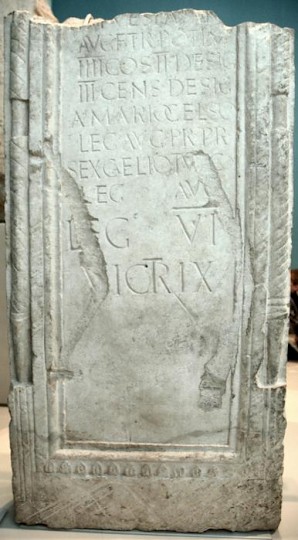
At first, they were very successful, but in 70, Vespasian sent a large expeditionary force to the north. VI Victrix was one of the legions involved. At Xanten, it was victorious in a hard-fought battle, which was commemorated in an inscription that mentions the new emperor and the commander of the sixth legion, Sextus Caelius Tuscus.
After this campaign, VI Victrix remained in Germania Inferior, where it had its quarters in Neuss, the former base of XVI Gallica. The fortress had to be rebuilt because it had been destroyed by the Batavians. Many soldiers must have served on other places in the province. For example, a tile from Iuliacum suggests that a nearby river crossing was guarded.
When in 89 the governor of Germania Superior, Lucius Antonius Saturninus, revolted against the emperor Domitian, the army of Germania Inferior (I Minervia, VI Victrix, X Gemina, XXII Primigenia) hurried to the south, to Mainz, and defeated the rebel. Every legion was awarded the title Pia Fidelis Domitiana ("faithful and loyal to Domitian"). When this emperor was killed in 96, the last element of this honorific title was dropped.
At the end of the first century, the sixth legion was transferred to Xanten, where it replaced XXII Primigenia. Many soldiers, however, did not stay at this base: during the Dacian wars, units of VI Victrix were sent to the Danube, which lay almost unguarded now that the garrisons were fighting in Dacia. One inscription suggests that a subunit of the Sixth was part of a task force with the other legions from Germania Inferior, I Minervia and X Gemina from Bonn and Nijmegen.
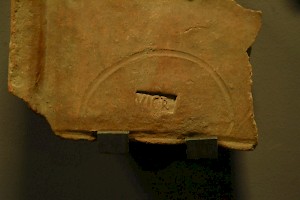
In 121, the emperor Hadrian visited Germania Inferior, where he ordered the construction of the Lower Rhine limes. The building activities were led by the governor, Platorius Nepos, a personal friend of Hadrian. Next year, the emperor visited Britain and took VI Victrix with him, together with Platorius, who now became governor of Britain. At the same time, VIIII Hispana came to Germania Inferior; it seems that the two legions traded places.
The soldiers of the sixth legion were now to build the British limes, which is better known as Hadrian's wall. (They built the section between Newcastle and Carlisle, and a bridge across the river Tyne near Newcastle.) The legion's new base was York, close to Hadrian's wall.
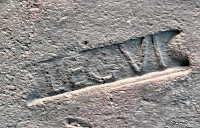
Later (between 139 and 142), units of VI Victrix helped constructing the Antonine wall, between Edinburgh and Glasgow.
In the years between 155 and 158, a widespread revolt occurred in northern Britain, requiring heavy fighting by the British legions. They suffered heavily, and reinforcements had to be brought in from the two Germanic provinces. At first, the Romans remained master of the area between Hadrian's wall and the Antonine wall, but at the beginning of the reign of Marcus Aurelius, it was abandoned. Hadrian's wall once again marked the northern frontier of the Roman Empire.
One of the officers serving in the legion in ca.165-166, was Publius Helvius Pertinax, who was to be emperor for a brief period in 193. After his death, civil war broke out between several generals: Pescennius Niger in the east, Didius Julianus in Italy, Septimius Severus in the northeast, and Clodius Albinus in the west. The two last-mentioned pretenders concluded an alliance, which gave Severus the opportunity to eliminate Didius and Pescennius. In 196, he and Clodius started a second round of civil war. The British legions were ferried to the continent, but were defeated by Lucius Septimius Severus near Lyon.
When they returned, they found the province overrun by northern tribes and VI Victrix had to recapture and rebuild York. The soldiers also reconstructed parts of Hadrian's wall. At the same time, the unit was awarded the title Fidelis Constans ("loyal and steadfast"). Usually, this title was awarded after a unit had prevented a rebellion, but we know nothing about such an incident.
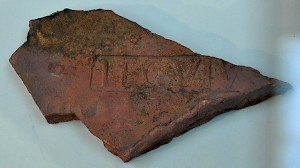
Punitive actions did not deter the tribesmen, and in 208, Septimius Severus came to Britain, in an attempt to conquer Scotland. VI Victrix moved to the north, where it shared a large fortress with II Augusta, at Carpow on the river Tay. During this war, it received the honorific title Britannica. From now on, the full name of the legion was VI Victrix Pia Fidelis Britannica. The conquests were abandoned at an unknown moment in the third century.
During this century, VI Victrix remained at York, and shared the fate of Britain. When this province was part of the Gallic Empire, it supported the Gallic emperors (260-274); when Britain became independent, it supported usurpers like Carausius and Allectus (286-297). After 297, the province was again incorporated in the Roman empire, and the soldiers served crown-prince (later emperor) Constantius I Chlorus. When he died in 306 in York, soldiers of the Sixth proclaimed his son emperor: Constantine the Great (306-337).
In the last third of the fourth century, Roman rule in Britain was increasingly threatened, and order had to be restored several times. VI Victrix must have suffered defeats. Yet, the legion still existed in the late fourth century. It may have been withdrawn to the continent in 402 by Stilicho, the supreme commander of the Roman forces in western Europe during the reign of Honorius.
Its legionary symbol probably was a bull.
Literature
- M. Hassall, "Pre-Hadrianic Legionary Dispositions in Britain", in: Richard J Brewer (ed.), Roman Fortresses and their Legions. Papers in honour of George C Boon (2000)
- M. Hassall, "Legionary fortresses in Britain", in: Yann Le Bohec, Les légions de Rome sous le Haut-Empire (2000 Lyon) 441-457
- L. Keppie, "Legiones Britanniae. Legiones II Augusta, VI Victrix, IX Hispana, XX Valeria Victrix", in: Yann Le Bohec, Les légions de Rome sous le Haut-Empire (2000 Lyon) 25-37
- A. Morillo Cerdán & V. Garcia Marcos, "Nuevos testimonios acerca de las legiones VI Victrix y X Gemina en la region septentrional de la península Ibérica", in: Yann Le Bohec, Les légions de Rome sous le Haut-Empire (2000 Lyon) 589-607
